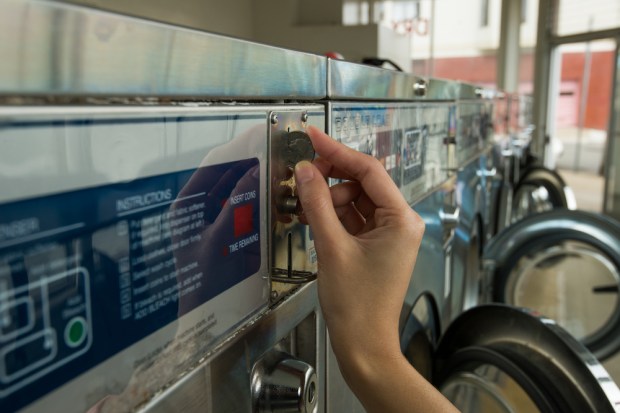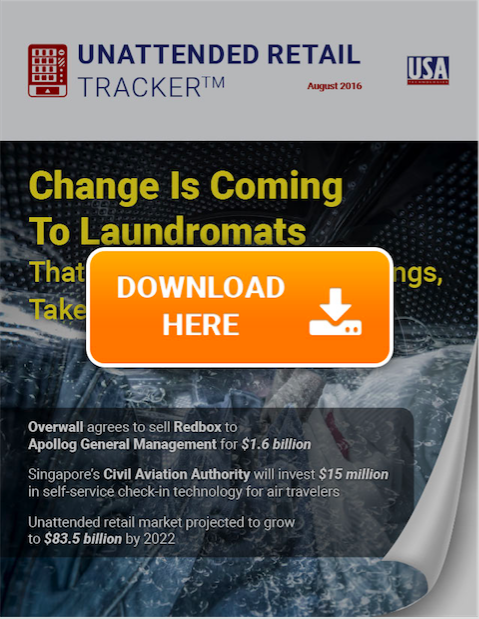Change Is Coming To Laundromats That Could, Among Other Things, Take Away The Change

Coin operated laundromats are a thriving industry, producing $5 billion in revenue a year, mostly in the form of quarters – that’s a lot of quarters. In this issue of the PYMNTS Unattended Retail TrackerTM, PYMNTS spoke with Michael Schantz, President of Setomatic Systems, about why the addition of credit, debit and mobile payments could mean even more revenue for the industry. You’ll find that along with the latest news from around the industry and a directory of 59 players in the Unattended Retail space in this month’s Tracker.
They may take payments in small amounts, but with more people moving to densely populated areas each year, coin-operated laundromats are a big business in the United States.
According to the Coin Laundry Association, there are more than 35,000 coin-operated laundromats in the country, generating nearly $5 billion in revenue each year, and the number of laundromats operating has grown consistently over the past 70 years. And, despite the advent of credit cards, debit cards and now new forms of cardless payment, that revenue is received almost entirely in 25 cent payment increments.
Unattended card and mobile wallet acceptance technology is starting to change that. Setomatic Systems is one of the companies working to give laundromat consumers more payment options via their SpyderWash system, which allows customers to pay for their laundry with credit and debit cards and mobile wallets, along with quarters (for the time being).
In a recent interview with PYMNTS, Michael Schantz, the company’s president, said he believes the addition of credit card, debit card and mobile wallet acceptance could boost that $5 billion in revenue to new heights. He noted that adoption is growing substantially, and said the company has doubled its transaction volume over the past year.
“We’re just at the tipping point in the laundromat market,” Schantz said. “The growth is starting to get explosive, and we just see that continuing, and there’s just great potential.”
For love of the cashbox
Despite the fact it only takes the drilling of a few holes and installation of some new wiring to set up the SpyderWash system, Schantz said that the biggest challenge in transforming the laundromat market from a cash-only business is convincing store owners to embrace new forms of payment.
He noted that most store owners do not want to give up the keys to their cash and coin boxes, and are perfectly happy with the existing setup. In order to convince them to do that, Schantz said, he has to sell them on the benefits of the card and mobile payments acceptance system, including a 5 to 35 percent increase in revenue seen by laundromats that have installed it.
“The store owner likes the quarters, likes the cash. So, our main challenge was to get them over the fact that they had to pay credit card fees, and they weren’t used to that in this market,” Schantz said, noting that the fees owners pay on credit cards are more than made up for by the increase in revenue.
Schantz also noted that laundromat owners have reported seeing an increase in new customers brought into the store by the ability to pay in several different ways.
“The thing about credit card usage is that it continues to grow over time for a store,” Schantz explained. “If they can pay with their credit card they tend to spend more money, and they might even pass a laundromat or two that are closer to them where they can only pay in cash.”
Changing perception about feeding machines
Schantz said that a large part of the reason he believes card and mobile payments can grow laundromat revenue is the convenience the new payment methods pose to customers.
Machines can range in price from $2 per load to as high as $12 per load, and most need to be paid for with quarters and accept payment only in quarters. He pointed out that finding and gathering those quarters and loading them into the machines can be a frustrating and time-consuming process.
“It’s not very convenient for a customer to sit there and find and insert that many quarters,” Schantz said. “So we said, ‘Let’s develop a product that will allow the customer to pay any way they want.’ It allows the customer to use coins if they so desire, but they can also use the debit or credit card that’s already in their pocket or a mobile wallet.”
Schantz said that he finds that most customers are still wary of mobile payments, despite their convenience and security features. He also noted that there is still plenty of education needed for consumers, who are often unaware of the different payment options available to them.
“The challenge is that people are still not all that used to them yet,” Schantz said. “They still don’t understand that that is a secure payment, that it’s more secure than swiping your credit card.”
To help combat that lack of customer knowledge, Schantz said that he and his team are working to teach customers about using credit and debit cards, as well as mobile wallets. They have also embraced partnerships to help market and improve the SpyderWash system.
Schantz said his team invested in security protections like a PCI-compliant gateway from USA Technologies, which ensures that no credit card information is stored on-site. They are also working on marketing strategies with USA Technologies and Apple to help get the word out about the system.
“We’re planning more education with the customers, and some store signage to let people know to use your credit card or mobile wallet here,” Schantz said. “It’s the easiest form of payment.”
The future of laundry? Magic smartphone says …
Schantz acknowledged that mobile wallets are still not used by many customers, largely due to a consumer’s lack of experience with them. He also noted that, when compared to debit and credit card swipes, mobile transaction volume is relatively small.
However, Schantz also pointed out that the usage of mobile payments is growing quickly and that the company sees monthly increases in the amount of money being spent via mobile wallets.
“I think it’s going to take some more education by Apple and Google and Samsung to let people know that this is a secure way to pay,” Schantz said. “Once a customer does use their Apple Pay, they tend to go wherever they can use it.”
Most people walking into laundromats and other retail locations already have their phones in their hands, Schantz said, and he believes the convenience of mobile payments will turn the method into a trusted and frequently used form of payment in the near future.
And as it turns out, Schantz said, he and his team have been preparing for the coming dominance of mobile payments for more than half a decade.“We feel that mobile payments will be the biggest source of growth for the future, and we’ve always felt that way. We built NFC into our system when we introduced it in 2009, and there was no such thing as Apple Pay or Google Wallet at the time,” he said. “In the coming year or two, we’ll start to see that form of payment really take off.”
“We feel that mobile payments will be the biggest source of growth for the future, and we’ve always felt that way. We built NFC into our system when we introduced it in 2009, and there was no such thing as Apple Pay or Google Wallet at the time,” he said. “In the coming year or two, we’ll start to see that form of payment really take off.”
To download the August edition of the Unattended Retail TrackerTM, powered by USA Technologies, click the button below …
About the Tracker
The PYMNTS.com Unattended Retail TrackerTM, powered by USA Technologies, tracks the movers and shakers in this space and ranks and scores the providers using this new channel to respond to changing consumer needs. We’ve sliced this ecosystem into the distinct categories that make sense for our audience: Food & Beverage, Vending, Service Vending, Remote Retail, Parking, and Restaurant & Hospitality.
The provider directory profiles key players in the space, and ranks them on the basis of the completeness of their solutions: markets served, technology solutions offered, payments accepted, and the security standards achieved. If we’ve missed you and you’d like to be included, please click here.

